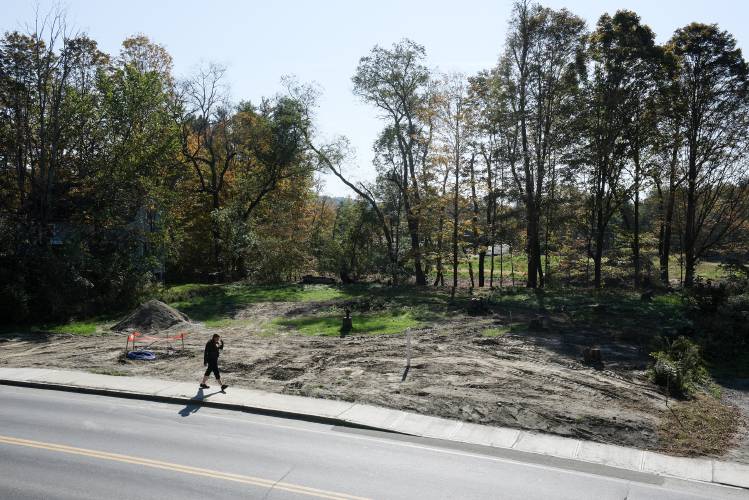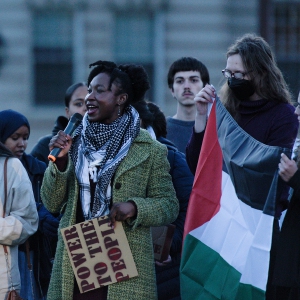Habitat for Humanity tries new approach with Randolph duplex project

Jessica Lawson, of Randolph, passes the Habitat for Humanity building site of a duplex on Central Street in Randolph, Vt., on the way to an appointment downtown on Tuesday, Sept. 3, 2023. (Valley News - James M. Patterson) Copyright Valley News. May not be reprinted or used online without permission. Send requests to permission@vnews.com. Valley News — James M. Patterson
| Published: 10-04-2023 6:23 AM |
RANDOLPH — Last month, Central Vermont’s Habitat for Humanity broke ground on its first-ever duplex project on Central Street.
The project may usher in a new era of cost efficiency and green energy for some of the state’s most affordable homes, according to Zachariah Watson, the organization’s executive director.
“Traditionally, we have built single-family houses,” said Watson. “We want to do our best to address the housing crisis by building more so we can serve more families. … A duplex is a more efficient use of land and resources, so we can also keep the cost of construction low.”
The organization’s projects are largely funded by community support. Typically, parcels of land and building materials are purchased at a reduced price or donated. The program also relies on monetary contributions and volunteer support.
“We depend on donations to support our projects,” said Watson. “This Randolph duplex has a budget right now of $672,000. We have to fundraise all of that.”
Additionally, the project is using a novel building method, in the hopes of reducing expenses and time while mitigating environmental impact. This is the organization’s first house to make use of “panelized construction,” in cooperation with a company called Bensonwood based in Walpole, N.H. The shell will be constructed off-site at an advanced manufacturing facility, then assembled by crane at the location.
“Cost of construction has skyrocketed since COVID,” said Watson. “What this enables us to do is build the house more quickly. … Because the walls are constructed in a controlled environment, we can actually reach higher energy efficiency levels, just because you don’t have to deal with moisture and exposure to the outside conditions.”
In the months leading up to the project, the organization conducted an advertising campaign in the community, collecting applications from a total of 17 prospective residents.
Article continues after...
Yesterday's Most Read Articles
 Herd departs Hartford’s last remaining dairy farm
Herd departs Hartford’s last remaining dairy farm
 At Dartmouth, hundreds protest ongoing war in Gaza and express support for academic freedom
At Dartmouth, hundreds protest ongoing war in Gaza and express support for academic freedom
 Claremont removes former police officer accused of threats from city committees
Claremont removes former police officer accused of threats from city committees
 Over Easy: ‘A breakfast without a newspaper is a horse without a saddle’
Over Easy: ‘A breakfast without a newspaper is a horse without a saddle’
“We try to find working families,” said Jack Kauders, executive director of Upper Valley Habitat for Humanity, who has led similar projects in Vermont and New Hampshire. “Our family committee speaks with them, and they pick people with important stories or folks who really need help.”
Once the duplex is completed, it will become a new home for two families. Rose Volpe, 60, and her two elementary school-aged grandchildren will occupy one of two 1,200-square-foot units with three bedrooms. The family has been crammed into a two-bedroom apartment in Randolph for two years.
“I’ve got a big hallway that I had to turn into a bedroom for my granddaughter,” Volpe said.
Volpe was born and raised in Greenfield, Mass. She lived with four siblings in her father’s home. The experience, she said, informed what she’d like for her grandchildren.
“We rent right now, no yard, no nothing,” she said. When a friend told her about Habitat for Humanity, she took the opportunity and applied for the property on Central Street.
Now she says she and her family couldn’t be more excited: “I’ve never had my own home. … It’s going to change our lives immensely. I’m really looking forward to it.”
The other half of the duplex will belong to Mediatrice Muzima, her two high school-aged children and her mother. The family currently lives in Montpelier.
Both families are expected to contribute 250 volunteer hours to help complete the project. Typically, once the home is ready, Habitat for Humanity will provide the new residents with two zero-interest mortgages. The first represents the amount the family can afford, and the second makes up the difference between the first and the cost of construction.
“If they keep their house for the full 30 years, they transfer it to their kids, the second mortgage just disappears,” said Kauders. “If they sell the house prior to that, then the buyer pays the second mortgage and that goes to Habitat. … We really want to encourage long-term ownership.”
This construction comes at a time when many Vermonters are struggling to find housing they can afford.
“It seems very clear that one of the big problems is the lack of affordable housing, and it’s not just for low-income people,” said state Rep. Larry Satcowitz, a Democrat, who also serves on the Randolph Selectboard. “The housing crisis that we’re having here in Vermont is not unique, but it does seem particularly bad, as evidenced by our very high homeless rate.”
Indeed, homelessness does represent a challenge for Vermonters. The state has the second-highest homeless rate in the country, around 0.43%, according to data from the 2022 Annual Homeless Assessment Report from the U.S. Department of Housing and Human Development.
A post-pandemic increase in the cost of materials combined with an insufficient workforce capacity means addressing these needs will be difficult.
“It’s hard to see right now that we’re going to be able to build enough new housing fast enough to meet the demand and actually bring costs down,” said Satcowitz.
Home ownership, according to Satcowitz, is deeply connected to a family’s wellbeing: “You’re really talking about getting to the very core of people’s quality of life, what it means to live in a healthy way.”
The benefits extend beyond the homeowners to their community at large, he said: “If people have a secure home, they then have the opportunity to participate in the community that they’re living in. … It makes for a better place, for everybody.”
These sentiments were echoed by Kauders, at the Upper Valley Habitat for Humanity. Not only does housing security drastically improve quality of life, he said, it also opens up a world of opportunity for the homeowners.
“If you have a house, that’s generational wealth. … It’ll help you have a retirement fund ... or it’ll help you get a second mortgage and pay for your kids’ college, or it’ll help your kids have a stable school to grow up in,” he said. “It’s a huge impact.”
The past few weeks have seen the completion of site work for the Central Street project’s water connections to Randolph’s municipal systems. Excavation began last week. Watson said crane assembly of the shell will take place sometime between the end of October and mid-November, at which point drywall construction and interior finish work can begin.
Watson hopes to complete construction in May 2024, allowing the homeowners to move in by June or July.
Upper Valley residents interested in donating or offering their services can sign up online at: centralvermonthabitat.org/volunteer.
Oliver Yukica can be reached at yukica.vt@gmail.com.


